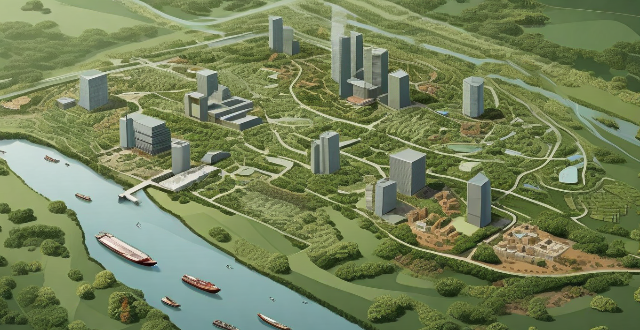Climate Ecosystem

How do climate change and ecosystem services interact ?
Climate change and ecosystem services are interconnected phenomena that impact our planet. Climate change affects ecosystem services such as water regulation, food production, air purification, and recreational opportunities. Conversely, ecosystem services play a crucial role in mitigating climate change by promoting carbon sequestration, conserving biodiversity, and supporting sustainable land use practices. To address these challenges effectively, it is essential to consider both climate change and ecosystem services holistically and work towards integrated solutions that protect our planet's natural systems while meeting human needs sustainably.

How do climate targets relate to ecosystem conservation efforts ?
The text discusses the interconnection between climate targets and ecosystem conservation efforts, emphasizing that both are essential for a sustainable future. Climate targets focus on reducing greenhouse gas emissions and adapting to climate change impacts, while ecosystem conservation aims to protect biodiversity and maintain ecological processes. The two concepts are closely related, as climate change affects ecosystems, and ecosystems play a role in climate regulation. An integrated approach combining these efforts can lead to more effective outcomes, such as reforestation projects that sequester carbon and provide habitat for wildlife. Collaboration between various stakeholders is crucial for aligning climate targets with ecosystem conservation efforts.

How do ecosystem-based adaptation methods contribute to climate resilience ?
Ecosystem-based adaptation (EBA) methods play a crucial role in building climate resilience by leveraging the natural capacity of ecosystems to mitigate and adapt to the impacts of climate change. These approaches focus on conserving, restoring, and promoting sustainable management of ecosystems to provide essential services that help communities cope with climate-related stresses. Below are several ways EBA methods contribute to enhancing climate resilience: Protection from extreme events, enhancement of biodiversity, promotion of sustainable livelihoods, regulation of water resources, carbon sequestration and storage, community empowerment and education, disaster risk reduction, and research and innovation.

What are some strategies for conserving and managing ecosystem services ?
Ecosystem services are vital for human survival and well-being, providing food, water, flood control, cultural enrichment, and more. To conserve and manage these services effectively, strategies include protecting natural habitats, using resources sustainably, managing watersheds, adapting to climate change, promoting education and awareness, implementing supportive policies and legislation, and conducting ongoing research and monitoring. These efforts aim to safeguard ecosystems for future generations.

How does biodiversity affect ecosystem services ?
Biodiversity plays a vital role in ecosystem services, including provisioning (like food and water), regulating (climate and flood control), cultural (recreational and spiritual enrichment), and supporting services (soil formation and nutrient cycling). Diverse plant species ensure resilience against pests and diseases, reducing the need for chemical interventions. Wetlands with varied vegetation types can more effectively filter pollutants from water than those with limited plant diversity. Different plant species play roles in carbon sequestration through photosynthesis, leading to more efficient carbon uptake and storage. Biodiversity can help regulate diseases by reducing the likelihood of pathogen spread. Diverse environments like coral reefs or tropical rainforests offer richer experiences for activities such as diving, hiking, and birdwatching. A variety of organisms, including bacteria, fungi, and earthworms, contribute to soil formation and maintenance, which is essential for plant growth. Different species have specialized roles in the cycling of nutrients. High biodiversity means functions can be performed by multiple species, providing a safety net if one species fails. Conservation efforts aimed at protecting and restoring biodiversity are vital for the sustained health of our planet's ecosystems.

What is the relationship between biodiversity and ecosystem services ?
The text discusses the relationship between biodiversity and ecosystem services, emphasizing that biodiversity is crucial for maintaining the health and functionality of ecosystems. It highlights that diverse species contribute to ecological processes, and many ecosystem services rely on specific species or groups. High biodiversity can lead to more resilient ecosystems, while its loss can diminish these services. The text suggests that conservation efforts can enhance both biodiversity and ecosystem services, underlining the importance of recognizing and protecting this relationship for human well-being.

Can you provide examples of different types of ecosystem services ?
The text provides a detailed summary of the four main types of ecosystem services, namely supporting, regulating, provisioning, and cultural services. Supporting services form the foundation for all other services and include nutrient cycling, soil formation, and primary production. Regulating services control ecological processes such as climate regulation, disease regulation, and water purification. Provisioning services provide direct material benefits to humans, including food, freshwater, timber, and medicine. Cultural services encompass non-material benefits that contribute to human well-being, such as recreation, spiritual enrichment, and educational opportunities. The text emphasizes the importance of understanding these different types of ecosystem services to appreciate the value of nature and the significance of conservation efforts.

What is the role of ecosystem services in sustainable development goals ?
Ecosystem services, including provisioning, regulating, cultural, and supporting services, play a vital role in achieving sustainable development goals (SDGs) by providing essential resources for human well-being and economic development while maintaining the health and resilience of natural systems. Provisioning services like food security, clean water, energy, and medicinal resources are crucial for meeting SDGs 2, 6, and 7. Regulating services such as climate regulation, disease regulation, and flood and erosion control contribute to SDGs 13 and 15. Cultural services like recreation and tourism and cultural and spiritual values support SDG 8. Supporting services like soil formation and nutrient cycling and pollination are essential for agriculture and hence SDG 2. The interconnectedness of ecosystem services with other SDGs highlights their importance in building resilient societies that can withstand future challenges such as climate change, environmental degradation, and economic fluctuations. Preserving and enhancing these services is essential for achieving a sustainable future for all.

What are ecosystem services and why are they important ?
Ecosystem services are benefits people obtain from ecosystems, including provisioning, regulating, cultural, and supporting services. These services play a crucial role in maintaining human health, well-being, and economic prosperity. Provisioning services provide food, water, timber, and medicinal resources necessary for human survival. Regulating services help control natural processes and mitigate disasters, protecting us from environmental hazards. Cultural services encompass non-material benefits like spiritual enrichment, recreation, and education. Supporting services enable the production of all other ecosystem services and are fundamental to the functioning of ecosystems. Preserving and enhancing these services through sustainable practices ensures a healthier planet and a brighter future for generations to come.

How can we measure the value of ecosystem services ?
The article discusses various methods to measure the value of ecosystem services, which are benefits humans derive from ecosystems. These include provisioning, regulating, cultural, and supporting services. Measuring their value is crucial for informed decisions about management and conservation. Methods include direct market valuation, indirect market valuation, revealed preference methods, avoided cost method, replacement cost method, and benefit transfer method. By using these techniques, policymakers and managers can make informed decisions about resource allocation for ecosystem conservation and restoration.

What is the impact of climate action on biodiversity and ecosystems ?
Climate action has both positive and negative impacts on biodiversity and ecosystems. Positive effects include reduction in greenhouse gas emissions, increased awareness and education, protection of key habitats, promotion of sustainable practices, and restoration of degraded ecosystems. Negative effects include displacement of local communities, habitat loss and fragmentation, ecosystem disruption, resource competition, and uncertain long-term outcomes. To maximize the benefits of climate action for biodiversity and ecosystems, an integrated approach that considers both environmental and social factors is crucial.

How does climate change affect biodiversity and ecosystems ?
Climate change, driven by human activities, significantly impacts biodiversity and ecosystems through various mechanisms such as temperature increase, changes in precipitation patterns, sea level rise, ocean acidification, extreme weather events, and altered species interactions. These effects can lead to extinction risk, habitat loss, food web disruption, and imbalances in ecosystem dynamics. Mitigating climate change and adapting to its consequences is crucial for preserving biodiversity and ecosystems.

How does climate vulnerability affect the environment ?
Climate vulnerability refers to the degree to which a system is susceptible to, and unable to cope with, adverse effects of climate change. This vulnerability can have profound impacts on the environment, affecting ecosystems, biodiversity, and the services they provide to humans. Key points include changes in ecosystems, loss of biodiversity, impacts on water resources, food security, and coastal systems. These changes can lead to altered migration patterns, changes in vegetation, disruption of life cycles, habitat loss, extreme weather events, invasive species, changes in snowmelt patterns, rainfall changes, shifting climate zones, pest and disease outbreaks, sea level rise, and ocean acidification. Addressing climate change is essential for the survival of countless species and the well-being of human societies that depend on the services provided by healthy ecosystems.

Can sustainable fishing practices help mitigate the effects of climate change on the environment ?
Sustainable fishing practices are crucial for mitigating the effects of climate change on the environment. These practices aim to conserve marine ecosystems, reduce carbon emissions from fisheries, promote responsible consumption, maintain biodiversity, enhance carbon sequestration, and promote ecosystem-based management. By adopting sustainable fishing practices, we can help maintain the health and balance of our oceans in the face of climate change. As individuals and communities, we must support these practices and make responsible choices when consuming seafood products to protect our planet's delicate ecosystems and ensure a sustainable future for all.

What are the effects of climate change on biodiversity and ecosystems ?
Climate change has significant effects on biodiversity and ecosystems, including habitat loss, changes in species distribution, altered ecosystem functioning, extinction risk, and impacts on human well-being.

Can carbon sequestration help to restore degraded ecosystems ?
Carbon sequestration can play a significant role in restoring degraded ecosystems by enhancing biodiversity, improving soil health, mitigating climate change, and providing ecosystem services. It should be part of a broader strategy that includes sustainable land use practices, conservation efforts, and reduction of greenhouse gas emissions.

How do climate disasters impact ecosystems and biodiversity ?
The article discusses how climate disasters like hurricanes, floods, droughts, and wildfires have significant impacts on ecosystems and biodiversity. It explains how these events can cause immediate damage to habitats, disrupt food chains, and lead to the extinction of species. The article also provides examples of how climate disasters have affected different ecosystems and species in various parts of the world. Additionally, it highlights the importance of adaptation and resilience in some species that are able to cope with changing environmental conditions. Overall, the article emphasizes the need for action to mitigate the effects of climate change and protect our planet's diverse ecosystems and biodiversity.

How do climate policies intersect with other environmental initiatives, such as biodiversity conservation ?
The text discusses the intersection of climate policies and biodiversity conservation, highlighting the importance of integrating these initiatives for a sustainable future. It emphasizes reducing greenhouse gas emissions, protecting ecosystems, promoting sustainable land use practices, encouraging collaboration, and integrating climate change into biodiversity conservation strategies as key points of intersection. The benefits of integration include enhanced ecosystem resilience, improved carbon sequestration, increased public awareness, more efficient use of resources, and greater policy coherence.

What are the impacts of climate change on sea levels ?
Climate change is causing sea levels to rise, which can have devastating consequences on coastal communities and ecosystems. The melting of ice sheets in Greenland and Antarctica, thermal expansion, loss of coastal wetlands, and increased erosion and flooding are all impacts of climate change on sea levels. It is essential to take action to mitigate the effects of climate change and protect our planet's ecosystems and communities from further harm.

How do urbanization and land use change affect ecosystem services ?
The text discusses the impact of urbanization and land use change on ecosystem services, including provisioning, regulating, cultural, and supporting services. It highlights how these changes can lead to decreased water supply, reduced food production, negative effects on climate regulation and flood control, loss of recreational opportunities and cultural values, and disruption of soil formation and nutrient cycling. Mitigation strategies such as green infrastructure, sustainable urban planning, and land stewardship are suggested to minimize these negative impacts and maintain essential ecological functions.

How does the climate emergency affect biodiversity and ecosystems ?
The climate emergency is causing significant changes in global temperatures, weather patterns, and precipitation, which have profound impacts on biodiversity and ecosystems. These effects include habitat loss and alteration due to rising sea levels, changing precipitation patterns, and temperature fluctuations. Species are being displaced or facing extinction as they struggle to adapt to new conditions, leading to disrupted food webs. The decline in ecosystem services such as water regulation, nutrient cycling, and disease regulation further exacerbates the situation. Resilience and adaptation challenges highlight the need for immediate action to mitigate damage and promote ecological resilience through conservation and sustainable practices.

How does climate change contribute to the climate emergency ?
The role of climate change in the current climate emergency is significant, driving various environmental issues that pose threats to our planet's health and stability. Key aspects include rising temperatures leading to heatwaves and melting ice, greenhouse gas emissions causing a greenhouse effect, extreme weather events such as intensified storms and altered precipitation patterns, wildfires and land degradation, ecosystem disruptions like biodiversity loss and ocean acidification. These impacts are far-reaching and deeply concerning, requiring urgent action to reduce greenhouse gas emissions and implement sustainable practices.

What legal mechanisms exist to protect ecosystems affected by climate change ?
Legal mechanisms are in place at international, nationalLegal mechanisms are in place at international, national protect ecosystems affected by climate Endangered Species Act, Clean Air Act, European Union legislation, and various local laws and ordinances. These frameworks aim to reduce greenhouse gas emissions, conserve biodiversity, and promote sustainable practices to mitigate the impacts of climate change on ecosystems.

How do extreme weather events influence biodiversity and ecosystems ?
Extreme weather events, such as flooding, drought, and heatwaves, significantly impact biodiversity and ecosystems. These events can cause habitat loss, species adaptation, and altered ecosystem structure and functioning. It is crucial to understand these impacts and take action to mitigate them through conservation efforts and climate change adaptation strategies. By doing so, we can help protect our planet's diverse flora and fauna and ensure the continued health of our ecosystems for future generations.

How does environmental degradation affect global ecosystems ?
Environmental degradation affects global ecosystems in various ways, including loss of biodiversity, disruption of ecosystem services, changes in the carbon cycle, and impact on human health. It is crucial to take steps to mitigate environmental degradation and protect our planet's ecosystems for future generations.

What is climate loss and damage ?
Climate loss and damage refer to the negative impacts of climate change on natural and human systems, including direct impacts such as extreme weather events and sea-level rise, and indirect impacts such as ecosystem changes and food security issues. Mitigating these impacts involves reducing greenhouse gas emissions and adapting to the inevitable effects of climate change.

What are some innovative examples of climate adaptation in developing countries ?
Climate adaptation is becoming increasingly important for developing countries, which often lack the resources to cope with the impacts of climate change. However, these countries are also finding innovative ways to adapt to changing environmental conditions. Here are some examples: 1. Integrated Watershed Management 2. Climate-Smart Agriculture 3. Ecosystem-Based Adaptation 4. Urban Green Infrastructure 5. Community-Based Adaptation

What are the potential consequences of climate change for forest-dependent communities ?
The article discusses the potential consequences of climate change for forest-dependent communities, including loss of habitat and alteration of ecosystems leading to reduced access to resources, changes in precipitation patterns affecting water availability, and impacts on agriculture and food security due to changes in crop yields and increased pests and diseases. Addressing these challenges requires a comprehensive approach that involves both adaptation strategies and efforts to mitigate the effects of climate change.

What is the significance of genetic diversity within biodiversity ?
Genetic diversity is a vital component of biodiversity, playing a crucial role in ecosystem health and stability. It enables species to adapt to environmental changes, resist diseases, contribute to ecosystem functioning, support food security, and provide medicinal plants. However, threats such as habitat loss, overexploitation, climate change, introduced species, and pollution pose significant risks to genetic diversity. Conservation efforts must prioritize the protection and restoration of genetic diversity to ensure the long-term survival of species and ecosystems.

What are the most effective strategies for adapting to climate change ?
Adapting to climate change is vital for survival and well-being. Effective strategies include building resilient infrastructure, enhancing ecosystem resilience, promoting sustainable agriculture, developing climate-resilient communities, investing in research and innovation, and strengthening governance and policy. These measures will help societies withstand climate challenges and ensure a sustainable future.